Totem Poles and Island History
by: Nattanya Hewitt
Editor's Note: This spring, TI Life received a question from Ron Daly, about the history of the totem poles located on Tar Island, near Rockport, ON. An email to Nattanya Hewitt, who has summered on the island with her family since the 1950s, produced some answers. Even better than that, Nattanya offered to write an article for Mr. Daly and our readers.
The west end of Tar Island, near Rockport, Ontario, Canada, is slightly different from other islands in the region because there are three totem poles on this property. There were Indigenous people in this part of the world for millennia, but in recent times, we settlers have dominated the area.
Totem Lodge
The Eaton family started the totem pole trend at the west end of Tar Island. In 1899, the New York City family bought this property, built a large summer home, and named the property Totem Lodge. They also had boats called Totem I and Totem II. They must have traveled extensively and brought home impressive souvenirs from their travels. Their souvenirs included valuable pottery from Acoma, New Mexico, various items from Egypt, and a Tlingit totem pole from the northwest coast of British Columbia and the south coast of Alaska [1].

I believe this pole was made for the tourist trade. It was not a highly treasured ancestral pole like the one recently identified in Scotland as having been stolen in 1929 from the Nisga'a people of NW British Columbia [2,3].
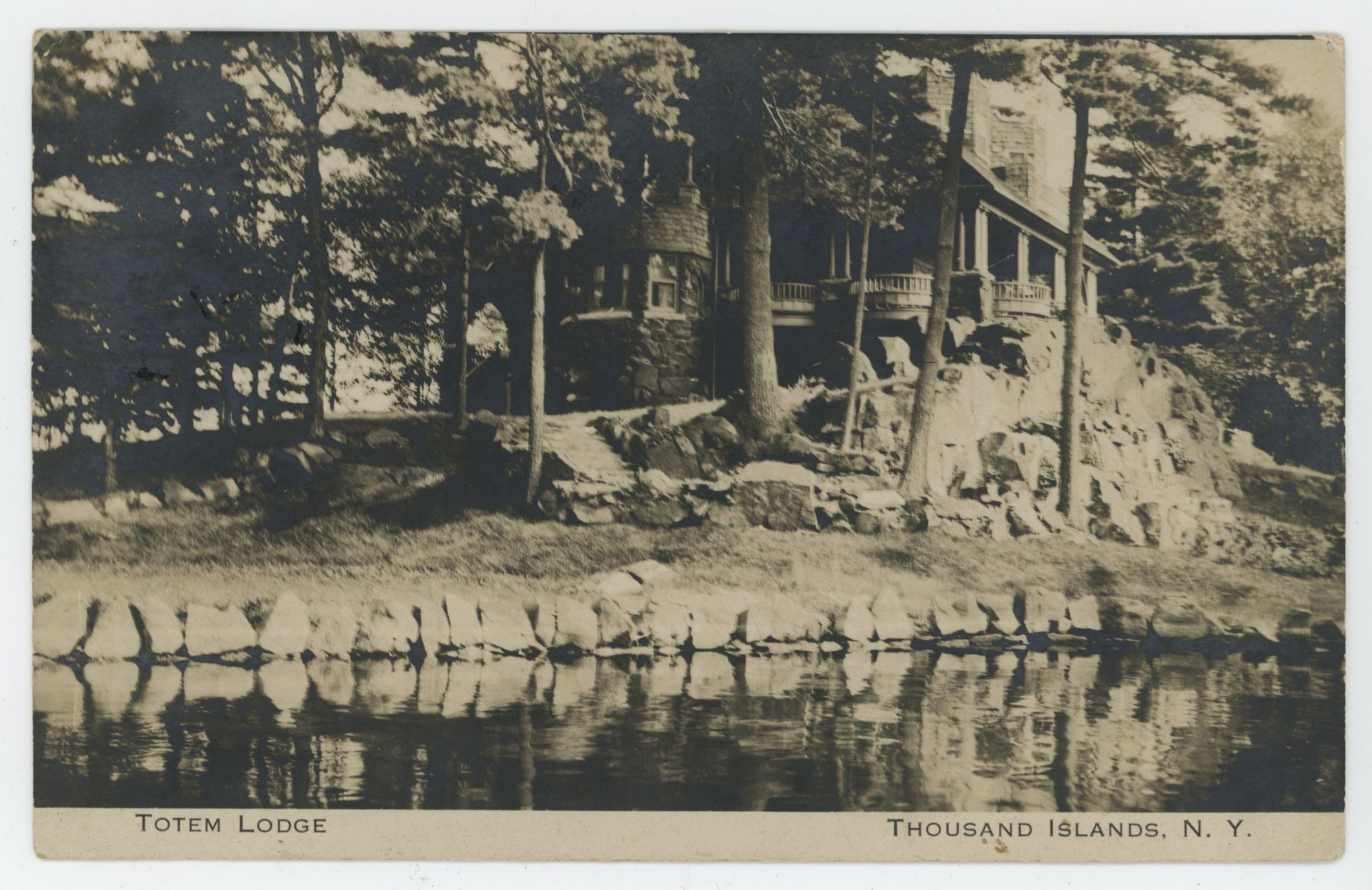
In 1920, G. E. Thing, who was in the shoe business in Rochester, New York, bought the property. The Thing family kept the totem pole and the boat named Totem II. They then bought a boat called Totem III, or the Big Totem. This was just before the Thousand Islands bridge was opened on August 18, 1938, because the family was delighted to take part in the boat parade that accompanied the opening of the bridge, in their new Big Totem boat.
Entourage of staff
Most wealthy islanders arrived for the summer with a large staff to run their summer houses. The Thing family brought an entourage of staff with them including Carl, the chauffeur and handyman extraordinaire, who kept all the engines and motors running properly, Edith, the English 2nd story maid, and one other person, the cook. From Rockport, the Things employed Hubert Fitzsimmons as a boatman. He was the son of Captain Fitzsimmons, the customs agent at Rockport. They also employed Owen O'Neill as a gardener; Owen, his wife Annie, and their children lived in Rockport, near the church [4].
Another local summer resident staff member had an extraordinary story; she survived crossing the Atlantic on the Titanic. Bridget Delia Bradley [5] left rural Ireland, crossed the Atlantic, and found work for the W. H. Nichols family. This wealthy New York City family summered at Nokomis Lodge on Howe Island. She met the Nichols family boatman, Bernard LaSha; Bridget and Bernard married, lived happily ever after in Gananoque, and continued working at Nokomis Lodge during the summers!
Back to the Totems
After the death of Mr. Thing, Herbert Fitzsimmons of Rockport continued to look after Totem Lodge, the boathouse, and the property around the house; he eventually purchased the property from the Thing family.
In 1956, Mary and Robert Hewitt of Montreal, Quebec, bought the property. They kept the totem pole but changed the property's name from Totem Lodge to Totem Point.
On a 1950’s trip to Harrison Hot Springs, British Columbia, they bought a second totem pole for the property, a pole also made for the tourist trade, and that pole still faces west from the most westerly part of Tar Island.
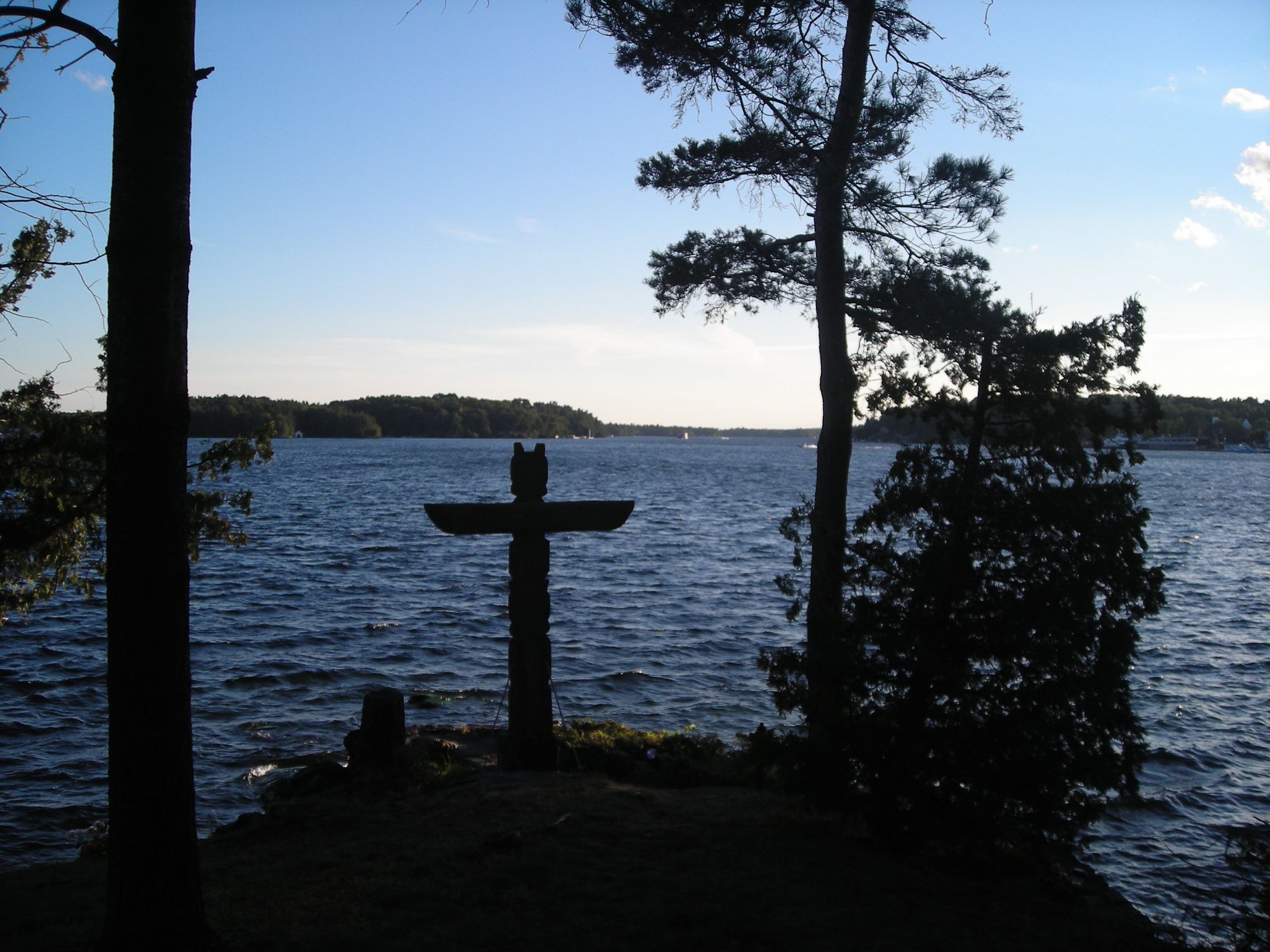
When the Hewitts bought the property in 1956, the old Eaton house was still standing, with its big verandas, multiple levels, and squirrels and acorns in every room. So, the Hewitts hired McGill University architect John Schreiber to design a house for the property; the house was built by F. M. [Fred] Hunt of Lansdowne, with Gordon Hunt, and Paul Morley. The home includes a magnificent Rockport granite fireplace in the main part of the house and five bedrooms in the bedroom section.
The boathouse on the north side of the property has been there since the early 1900s, with two boat slips, a kitchen, a living room, and four bedrooms. There is also a system for lifting boats for winter storage, with two iron I-beams and chain hoists.
Theft!
In August 2010, my son (Mary Hewitt's grandson), Chris Ferguson, and his family were staying on the island when they noticed that the Tlingit totem pole was missing! Shortly after that, a boat went by the point, and Chris could hear the conversation; someone said, "That is where the totem pole came from!" So Chris and a friend from Rockport got into a boat and followed that boat to a nearby cottage. There on the cottage porch was a piece of the totem pole, which was the good news. The bad news was – the pole had been cut into pieces. So, with one piece of the pole in hand, we still knew nothing about the other pieces.
Come October after the pole went missing, I decided to walk down Tar Island on the path under the hydro line, to see if any more pieces of the pole had been hidden under the vegetation along the path and would now be more visible because the vegetation was dying off. I was shocked when I did find one more piece of the pole! Just before winter and snow arrived, Angela and Jim Hodge found a third piece on the island.
Eventually, all the pieces were found and returned to Rockport. The next spring, Jon Hewitt, another grandson of Mary Hewitt’s and one who is the proprietor of a fine wood working company, Leon Lebeniste Ltd, in Squamish, British Columbia glued the pieces back together, and the pole is now back on the south side of Tar Island.
In the meantime, however, when we discovered that the pole was gone, Mary Hewitt, who still summered on the island, decided to order a new totem pole. With help from her daughter, Susan Hewitt Henwood, a new pole was ordered through the Alcheringa Gallery in Victoria, British Columbia. It was to be carved by master carver Calvin Hunt [6].
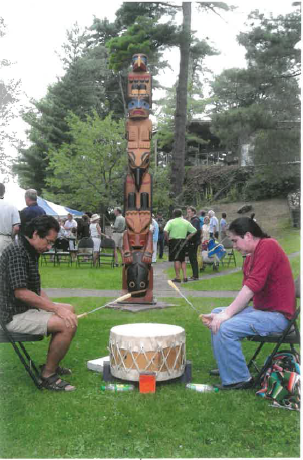
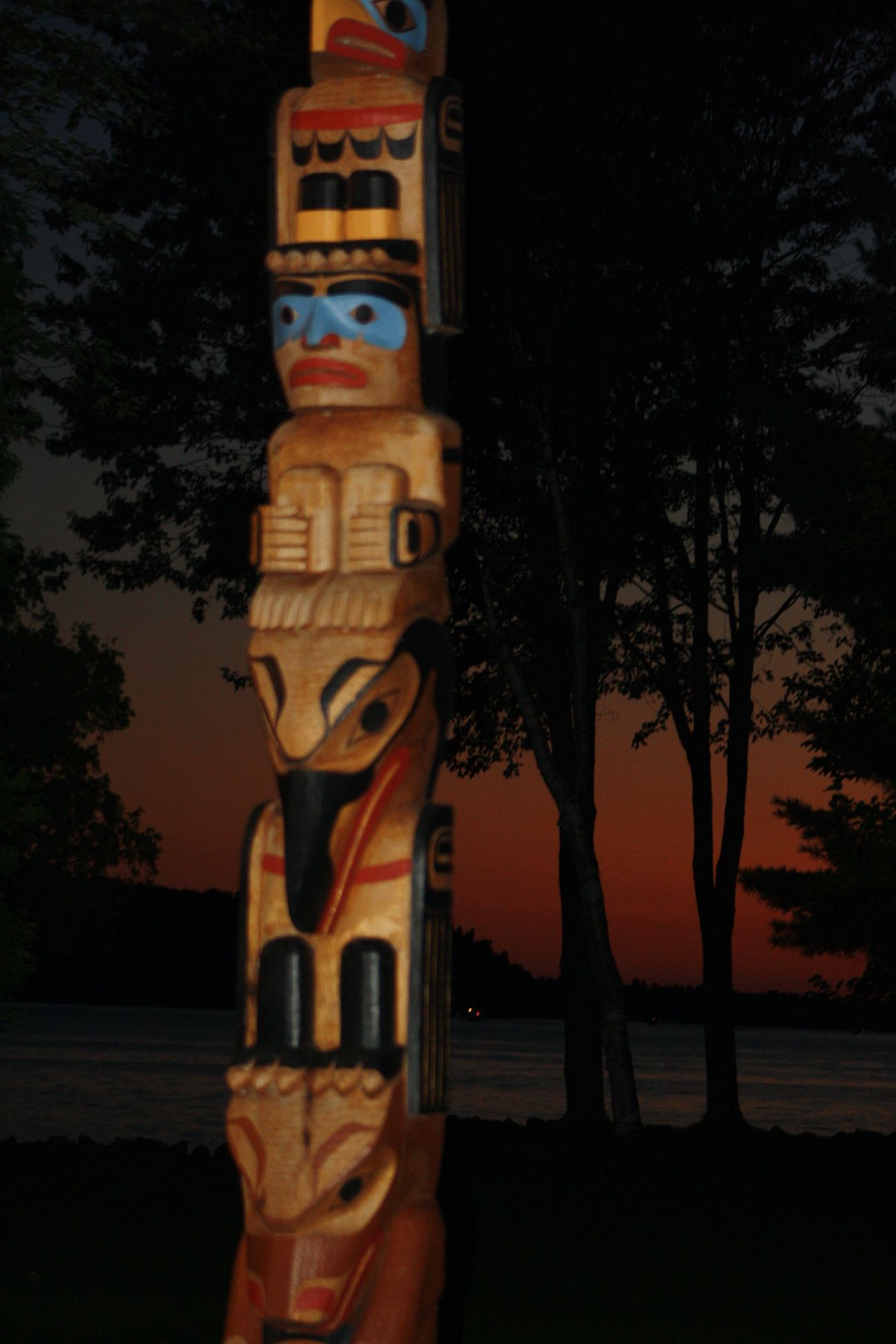
A suitable tree was found, seasoned, the pole was carved, transported across Canada, moved to the island, and unveiled in August 2011. The pole can be seen when traveling along the south shore of Tar Island.
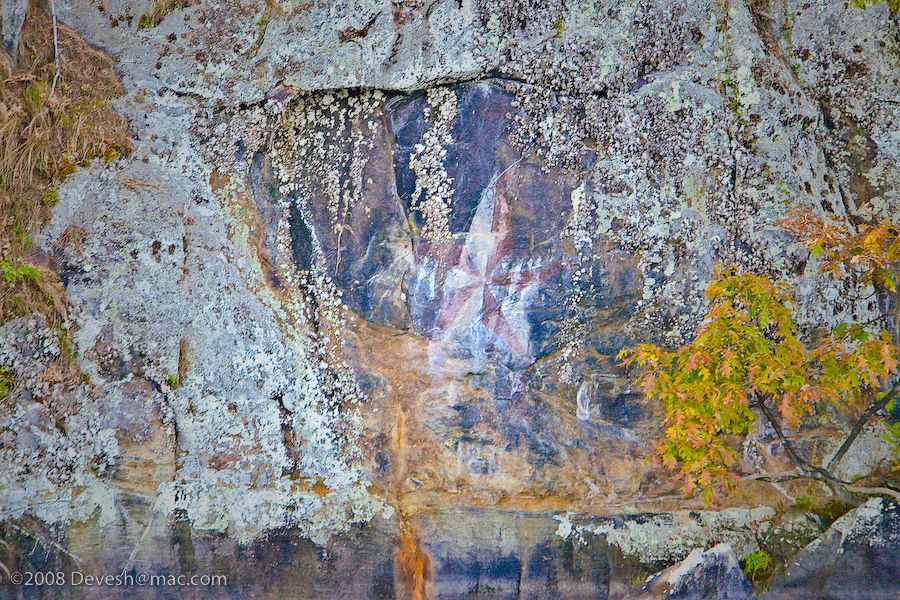
Another interesting feature of the western end of Tar Island is a painting on the cliff face on the south side of the island, about halfway between the tennis courts and a neighbouring boathouse. This painting, now very faint, shows an anchor and the date 1876. My own theory about the rock painting is that American summer residents painted it in 1876, to commemorate the 100th anniversary of 1776. I was told that in the early 1900s, some men from Rockport, who were involved in the growing tour boat business, touched up the rock painting. Thanks to Devesh Komaromi for the photo, taken in 2008.
The totem poles of Tar Island were brought here by settlers and cottagers. Indigenous people indeed were in the Thousand Island area in the past. Many cottagers on Tar and Grenadier Islands have an arrowhead or two on the mantelpiece; at least one cottage has a bucket full of arrowheads. Some Indigenous artifacts were sent from Tar and Grenadier Islands to a museum in New York City.
There is also a section called "The Sandbanks" on the south side of the island, near Duck Island, where cottagers have found arrowheads and other evidence of Indigenous life. A summer Indigenous village in this part of the Thousand Islands was called Toniata, however, its exact location is unknown. It may have been at the mouth of Jones Creek, on Grenadier Island, or at the Narrows on Tar Island.
Learning the history of Indigenous life on the islands long before wealthy summer residents arrived is difficult. Parks Canada sponsored a dig on Gordon Island near Gananoque [7], and their results showed that small bands of people used the islands on a seasonal basis beginning 9,000 years ago. But I am not aware of any documented digs on Tar Island.
Perhaps the arrowheads and artifacts collected by cottagers will one day be assembled and preserved for future generations. And a similar excavation and even a similar study will be undertaken on Tar Island.
Endnotes:
- The original pole on the island was Tlingit from the northwest coast of British Columbia. The Tlingit (sometimes also known as the Łingít) are Indigenous peoples of the Pacific Northwest Coast of North America who share a common cultural heritage. Tlingit means “people of the tides.” In the 2016 Canadian Census, 2,110 people identified as having Tlingit ancestry.
- First Nation members arrive in Scotland, and ask museum to return totem pole taken in 1929. The nation said the pole was taken in 1929 without its consent by ethnographer Marius Barbeau while members were away from their villages for the annual hunting and food harvesting season, and it was later sold to the museum in Scotland. Reference: Brieanna Charlebois, The Canadian Press Aug 21, 2022
- Additional family history can be found in the The First Summer People, by Susan Weston Smith. The reference on page 176 reads:
"The west end of Tar Island was purchased in 1899 by Dr. Eaton, a Universalist minister from New York City. The Eatons built a large summer home that was admired by many tourists. Their daughter Anne Thaxter Eaton was a professor of children's literature at St. John's University in New York City. She was also the children book reviewer for the Sunday edition of the New York Times. Every week she received a supply of new books. After reading them and writing her reviews, she would send the books to the Rockport Public School, thus providing a valuable library for the summer community she loved so much." - Information from an email from Jean Thing Frevert, a granddaughter of former owners the Things. Jean also visited Totem Point with her son Doug Frevert and his wife Lin in the summer of 2009.
- Unsinkable Bridget, Titanic Survivors Life Story by Mary Higgins, 1985, published by Baico Publishing.
- Calvin Hunt, famous carver, carved the new pole. Calvin Hunt (b. 1956) is a member of the Fort Rupert Band of the Kwakwaka'wakw Nation. He is renowned for large, monumental sculptures. He has lived in Fort Rupert since 1982. In May 1988, Calvin carved and raised the Hunt Pole, which is hereditarily owned by his brother, Chief George Hunt Sr. He also carved a memorial grave figure for his father at the Fort Rupert Cemetery. These poles were the first such poles to be raised in the village for 70 years. Calvin continues his work in Northwest Coast Indian Artwork, working in wood, including canoe building, original silk-screened prints, gold and silver jewelry, and stone carving.
- “The picture that has emerged to date from the Gordon Island North excavations is one of small bands of people exploiting the island and surrounding resources on a seasonal basis beginning 9,000 years ago and continuing into the historic period. During the 1,500 years between 500 B.C. and A.D. 1000 the island appears to have been incorporated, in a relatively continuous fashion, into the seasonal round of prehistoric peoples. Family groups are involved as suggested by the presence of mature and juvenile pottery vessels. The limited paleo-environmental data suggests late summer to fall occupation. It can also be inferred from the location of the site that some form of watercraft was employed; probably the bark canoe. Indeed, the richness of the material culture of these prehistoric peoples is undoubtedly reflected in the most limited way by the few remains that have survived the passage of time. Of their non-material or intellectual culture, we know nothing.” Reference from Thousand Islands Life, Archaeology 2021.
By Nattanya Hewitt
Nattanya Anne Hewitt grew up in Toronto and Montreal. From birth she summered at Heather's Point on the west side of Brockville at the summer home of her maternal grandparents, Myrtle and Robert Jackson Jowsey. In 1956 her parents bought Totem Point at the west end of Tar Island and summers were spent there. She is a graduate of ECS in Montreal, Manhattanville College, and Queen's Law School. While living in Rockport and Brockville between 2002 and 2017, she was chair of the Township Taxpayers, a group which aimed to support good governance in the Township of Leeds and the Thousand Islands. Nattanya now lives in Kingston, Ontario.


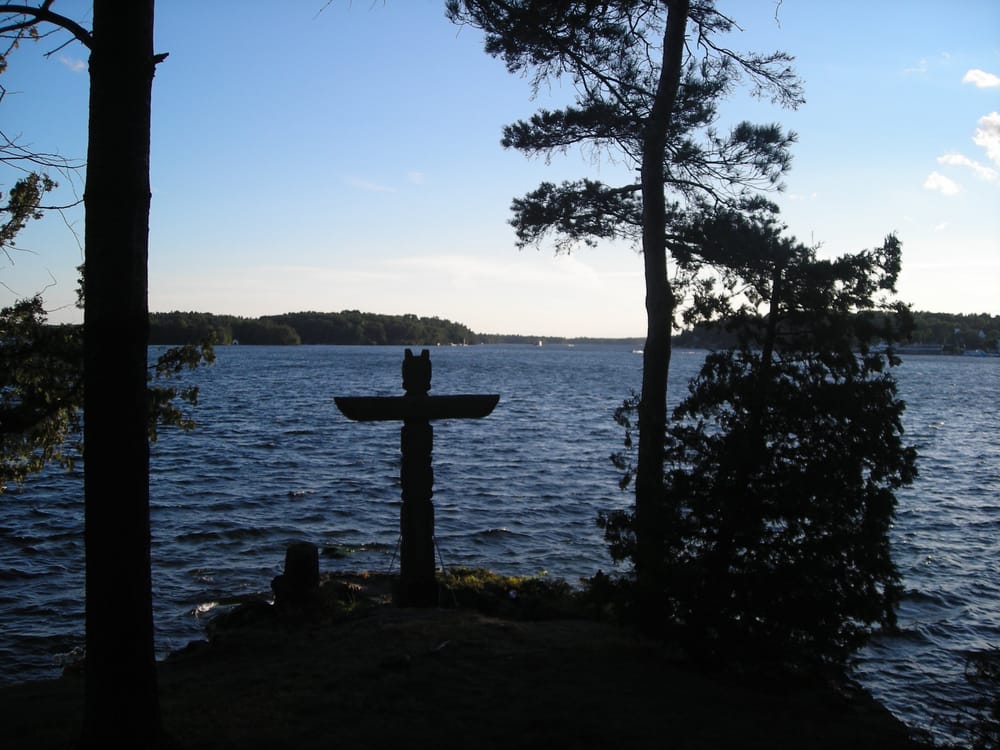



Please click here if you are unable to post your comment.